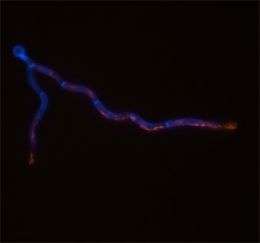Yeast behind potentially deadly infections tackled by multi million pound collaboration

How yeast infections fight off multiple attacks from the human immune system is the subject of a new study awarded £4.6 million today. The team of internationally renowned scientists receiving the grant hope their findings could pave the way for better and more effective anti-fungal drugs.
Researchers will make use of an exciting new approach to life sciences research called systems biology. By combining researchers from biological, physical and computational disciplines, this offers a much more powerful and efficient way of studying complex biological problems.
The project will focus on the yeasts Candida albicans and Candida glabrata which live in our bodies and are usually kept in check by our immune systems. But if the yeast is not reined-in it can grow and cause infections such as thrush which is suffered by most women at some point in their lives. In general, this is easily treated with anti-fungal therapies.
However, out-of-control Candida can be life threatening in people with weakened immune systems such as cancer patients and those who have had transplants. Candida infections are a relatively common cause of bloodstream infections among some patient groups with severe immune deficiencies and about 30-40%of those cases can be fatal.
Now thanks to funding from the Biotechnology and Biological Sciences Research Council (BBSRC), researchers from the University of Aberdeen and Imperial College London are about to embark on an entirely new approach to investigating the organism.
Biologists, mathematicians, statisticians and computer scientists are joining forces to spend the next five years exploring in detail the daily battles our bodies have with these members of the fungal family.
Up until now, research in this field has examined how Candida reacts to single steps taken by our immune systems to fend off the fungus. Now for the first time scientists will look at how Candida fights for its life against multiple counter measures taken by our bodies to try to kill it off. They are able map the defence mechanisms of the fungi in this way by using state-of-the-art computational modelling.
Professor Al Brown, Chair in Molecular and Cell Biology at the University of Aberdeen and Director of the project, said: "This is a tremendously exciting interdisciplinary research project which aims to understand how these medically important fungal pathogens protect themselves against attack from our immune systems.
"Our research should dramatically advance our understanding of these organisms and, in the longer term, this should contribute to the development of more effective antifungal therapies.
"The project represents a revolution in the way that we approach biological systems in which organisms are subject to combinations of many different stimuli. This is the case for most real biological situations, and hence the methods that we develop will be relevant to many other important biological problems."
Mathematician Professor Jaroslav Stark, Director of the BBSRC/EPSRC Centre for Integrative Systems Biology at Imperial College, added: "The exciting thing about this project is the opportunity that Systems Biology offers for scientists from many different disciplines to contribute to biological problems that are important to our society. Working in such an interdisciplinary team is very stimulating, since each discipline has different insights and different perspectives. When these are combined we have the possibility of creating radically new approaches to the study of biological systems. It's an incredibly exciting way in which to apply mathematics!"
Professors Brown and Stark lead a team of international experts in Candida biology and computational modelling from the University of Aberdeen and Imperial College London.
The experimental biologists include Professor Neil Gow and Dr Ken Haynes. The modellers include Professors Celso Grebogi and Michael Stumpf, and Drs George Coghill, Alessandro Moura, Marco Thiel and Maria Carmen Romano.
The funding also enables the hiring of four new researchers at each institution, and the training of four post-graduate students.
Source: University of Aberdeen

















